Professor Geraldene Wharton, BSc Hons (Sheff) PhD (Soton)

Professor of Physical Geography
Email: g.wharton@qmul.ac.uk
Telephone: +44 (0)20 7882 5439
Room Number: Geography Building, Room 111
Profile
I am a river scientist, Fellow of the Royal Geographical Society with Institute of British Geographers, and a Chartered Geographer (Geomorphologist) with over 35 years’ research experience in hydrogeomorphology. My research on rivers focuses on:
- interactions between water, plants and sediments, with special expertise in chalk streams;
- entrainment and transport of fine cohesive sediments;
- river restoration and integrated catchment management;
- physical habitat assessment methods for non-tidal and tidal / estuarine river reaches.

Bere Stream at Snatford Bridge is one of my study sites in the Frome-Piddle Catchment, Dorset, UK (photo: G.Wharton)

Morecombe Bay upper estuary, NW England is a site used in the development of MoRPh Estuaries, a method for assessing and monitoring the physical habitat condition of estuary margins (photo: J. Greef)
After completing a BSc Honours degree in Geography at the University of Sheffield and a PhD at Southampton University, I held a Natural Environment Research Council (NERC) Post-Doctoral Research Fellowship before joining the School of Geography at Queen Mary University of London. I have held numerous positions within the School including: Undergraduate Admissions and Recruitment lead, Chair of the Environmental Science Examinations Board, Senior Tutor, and Programme Director for the MSc Water and Environmental Management.
My current role is Director of Student Experience and Employability and in 2024 I received a VP Special Prize, with Matthew Halfin (Careers and Enterprise) and Tim Edkins (School of Politics and International Relations) for “developing and implementing a coherent and consistent employability framework across Schools in the Faculty of Humanities and Social Sciences”.
I am a member of the NERC Peer Review College and serve on the Editorial Boards of the Journal of Soils and Sediments and River Research and Applications. Past appointments have included: Chair of the Board of Directors of the UK River Restoration Centre; Board Member of the London Waterways Partnership, Canal & River Trust; Honorary Secretary of the Royal Geographical Society with Institute of British Geographers (Education); Secretary of the Geography Section of the British Association for the Advancement of Science.
Teaching
I teach on the BSc Programmes in Geography and Environmental Science at all levels and the MSc Water & Environmental Management, and my teaching is informed by my research and stakeholder engagement. For example, through my work in river restoration, students are introduced to current policy and practice in river restoration. Classes are interactive with frequent opportunities for discussion and debate, and site visits to restoration schemes allow students to gain first-hand knowledge of restoration design, engage with practitioners, and develop an appreciation of the challenges and benefits of restoring rivers.
Currently, I teach on:
- GEG5225 Geomorphology
- GEG6099 Dissertation supervision
- GEG7317 River Restoration and Assessment (module convenor)
- GEG7318 Catchment Science in Practice (module convenor)
Research
Research Interests:
My research adopts an inter-disciplinary approach to study river forms and processes that can inform sensitive and sustainable management. My expertise is in geomorphology and hydrology and I work with ecologists and environmental engineers to study: how plants, water, and sediments interact in rivers; the characteristics of fine sediments in rivers, their dynamics, and environmental impacts; and the benefits of river restoration.
Plant-water-sediment interactions in rivers
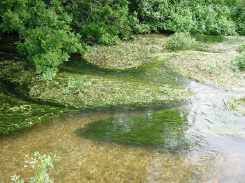
Submerged aquatic vegetation (Ranunculus sp. / Watercrowfoot) on the River Frome at Maiden Newton, Dorset, UK (photo: G.Wharton)
Many rivers contain aquatic plants growing in the centre of the channel (submerged) and at the margins (emergent) and a key focus of my research has been studying their role as ecosystem engineers by modifying flow patterns and the processes of sediment deposition, entrainment and transport. I was PI on a project within the NERC Lowland Catchment Research Thematic Programme (NER/T/S/2001/00932) that established the significance of several key biotic processes for sediment modification (e.g. Cotton et al., 2006; Wharton et al., 2006; Heppell et al., 2009) and the implications of nutrient-rich sediments retained within aquatic plants for methane release and river health (Sanders et al., 2007).
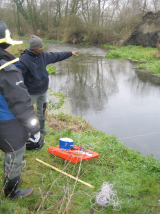
Measurement of flow velocity on the River Lambourn at Boxford using an Acoustic Doppler Velocimeter (photo: G.Wharton)
Another important issue in lowland vegetated rivers is weed cutting, routinely carried out for flood risk management. I have worked with researchers from CEH Wallingford on the River Lambourn (Adam Sutcliffe, CEH NERC Studentship) to measure and model the detailed flow hydraulics following different weed cutting strategies to inform management decisions about the optimum levels of aquatic plant cover.
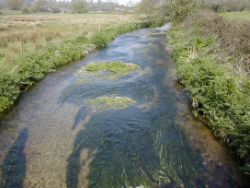
Inter-disciplinary research through an international collaboration with scientists in the Netherlands and Belgium has combined empirical field measurements with flume experiments and numerical modelling to establish the patterning of submerged vegetation (Cornacchia et al., 2018; 2019 a, b), and the implications for water and sediment conveyance. In particular, we have been able to show how instream vegetation can self-organize in response to changing hydrological conditions and in turn regulate water levels and flow (Cornacchia et al., 2020). This important buffering capacity of instream vegetation against both low flows and high flows can support the maintenance of healthy ecosystems and offers a nature-based solution to flow regulation.
Entrainment and transport of fine cohesive sediments
In recent decades increased inputs of fine sediments to lowland rivers have resulted in the ingress of silts, clays and sands into gravels, excessive surficial deposits, and elevated levels of sediment-bound contaminants.
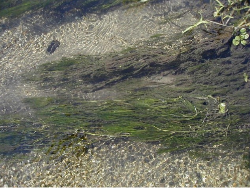
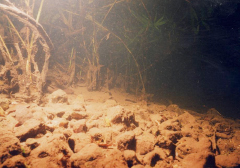
Excessive fine sediment deposits within a macrophyte stand over a gravel bed affecting river health (photo: L. Baldock)
Research in the Frome-Piddle Catchment, Dorset, (Robert Grabowksi QMUL PhD Studentship) in collaboration with Ian Droppo (Environment Canada) examined the spatial and temporal variations in the erodibility of fine sediment deposits, using a Cohesive Strength Meter (Grabowski et al., 2012). We combined these field measurements with experimental flume work to develop a calibration to allow CSM measurements taken in the field to be expressed as critical shear stress values to help further knowledge of entrainment thresholds for fine cohesive sediments (Grabowski et al., 2010) based on an understanding of the physical, biological, and chemical factors that determine a sediment's erodibility (Grabowski et al., 2011).
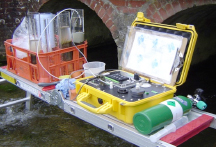
Measuring the erodibility of surficial fine cohesive sediments in the field using a Cohesive Strength Meter (photos: R. C. Grabowski)
Parallel research (Luke Warren NERC PhD Studentship; Grieg Davies NERC PhD Studentship) focused on quantifying how much fine sediment is transported in vegetated river reaches (Warren et al., 2009) under seasonally changing vegetation cover and how much fine sediment is stored (Heppell et al., 2009). This work is being developed to consider the residence times of fine sediments and sediment-bound contaminants in vegetated rivers.
More recently, flume experiments conducted with scientists at the University of Trento, Italy (Seyed Hossein Mohajeri EMJD PhD Studentship) have established the hydraulic conditions and turbulent flow structures over a gravel bed to further understanding of the processes of fine sediment ingress and decolmation (Mohajeri et al., 2016; Wharton et al., 2017; Stradiotti et al., 2020).
River restoration
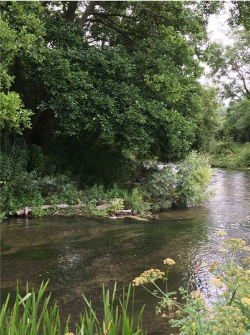
In recent decades restoring large wood (LW) to rivers has been a growing activity (Cashman et al., 2018) to deliver ecological benefits and Natural Flood Management by 'slowing the flow'. I have undertaken research (Matthew Cashman and Francesca Pilotto EMJD PhD studentships) showing the benefits of LW for physical habitat diversity and invertebrate communities (Cashman et al., 2016 a, b; Pilotto et al., 2014; 2016) and the importance of LW structural complexity for ecosystem engineering.
To date river restoration activities have been focused on the reach scale but the benefits of a catchment-scale approach are widely recognised and aspired to. Current work with researchers at UCL (Helen Bennion and Carl Sayer; Tahir Khanzada is undertaking a detailed study of the River Glaven catchment, Norfolk, to develop a palaeoecological approach to assist conservation at the catchment scale.
Please refer to Stakeholder Engagement for further details on river restoration work including biophysical habitat assessment of rivers and estuary margins.
Publications
A full list of my publications is available on the Queen Mary research site and Google Scholar. The following is a chronological list of papers published since 2014:
Gurnell, A., Bertoldi, W., Francis, R.A. and Wharton, G. (2024), Special issue: Fluvial biogeomorphology. River Research & Applications, 40: 884-886. https://doi.org/10.1002/rra.4330.
Wharton, G., Bertoldi, W., & Francis, R. A. (2024). Celebrating the career of Angela Gurnell. River Research and Applications, 40(6), 877–883. https://doi.org/10.1002/rra.4328
Wharton, G., Phillips, J., Legout, C. and Grabowski, R.C. (2023). Preface: understanding fine sediment dynamics in aquatic systems. J Soils Sediments 23, 3567–3573. https://doi.org/10.1007/s11368-023-03655-z
Gurnell, A., Downs, P., Tooth, S. & Wharton, G. (2023) Professor Kenneth John Gregory (1938–2020): The career, contributions and legacy of an eminent geographer and fluvial geomorphologist. Earth Surface Processes and Landforms, 48(1), 34–46. Available from: https://doi.org/10.1002/esp.5377
Wharton G, Gurnell AM, Ross M and Pereira-Gurnell D (2022) The PlaceMarker Survey: A Place-Based Tool for Supporting the Monitoring and Appraisal of River-Related Projects and Natural Capital Assessments. Water 14(16): 2514. doi.org/10.3390/w14162514
Licci S, Marmonier P, Wharton G, Delolme C, Mermillod-Blondin F, Simon L, Vallier F, Bouma TJ and Puijalon S (2022) Scale-dependent effects of vegetation on flow velocity and biogeochemical conditions in aquatic systems. Science of The Total Environment 833, p.155123. doi: 10.1016/j.scitotenv.2022.155123.
Cashman M, Harvey GL and Wharton G (2021) Structural complexity influences the ecosystem engineering effects of instream large wood. Earth Surface Processes and Landforms 46: 2079–2091. doi: 10.1002/esp.5145
Brighenti S, Engel M, Tolotti M, Bruno MC, Wharton G, Comiti F, Tirler W, Cerasino L and Bertoldi W (2021) Contrasting physical and chemical conditions of two rock glacier springs. Hydrological Processes 35(4): p.e14159. doi:10:1002/hyp.14159
Brighenti S, Toletti M, Wharton G, Bertoldi W and Bruno MC (2021) Rock glaciers and paraglacial features influence stream invertebrates in a deglaciating Alpine area. Freshwater Biology 66:535-548 https://doi.org/10/1111/fwb.13658
Cornacchia L, Wharton G, Davies G, Grabowski RC, Temmerman, S, van der Wal, D, Bouma TJ and van de Koppel J. (2020) Self-organization of river vegetation leads to emergent buffering of river flows and water levels. Proc. R. Soc. B doi.org/10.1098/rspb.2020.1147
Gurnell AM, Scott SJ, England J, Gurnell DJ, Jeffries R, Shuker L and Wharton G (2020) Assessing River Condition: A Multiscale Approach Designed for Operational Application in the Context of Biodiversity Net Gain. River Research & Applications. DOI: 10.1002/rra.3673.
Serlet AJ, M López Moreira GA, Zolezzi G, Wharton G, Hölker F, Gurnell AM, Tockner K, Bertoldi W, Bruno MC, Jähnig SJ, Lewandoski J, Monaghan MT, Rilling MC, Rogato M, Toffolon M, Veresoglou SD, Zarfl C (2020). SMART Research: Towards interdisciplinary river science in Europe. Frontiers in Environmental Science – Freshwater Science. Vol 8 Article 63; doi: 10.3389/fenvs.2020.00063.
Stradiotti G, Righetti M, Tarekegn TH, Wharton G and Toffolon M (2020) A new conceptual framework for the erosion of fine sediments from a gravel matrix based on experimental analysis. Journal of Hydraulic Engineering 146(9): 0402006. DOI: 10.1061/(ASCE)HY.1943-16 7900.0001795.
Brighenti S, Bruno MC, Toletti M, Wharton G, Engel M, Pusch M, Cerasino L and Bertoldi W After the peak water: Alpine streams under the increasing influence of permafrost thaw (2019). Hydrological Processes. DOI:10.1002/hyp.13533.
Gurnell AM, England J, Shuker L, Wharton G. (2019). The contribution of volunteers to river monitoring: international and national perspectives and the example of the MoRPh survey. River Research & Applications, 35: 1359-1373. DOI.10.1002/rra.3483.
Pinter N, Brasington J, Gurnell A, Kondolf GM, Tockner K, Wharton G and Yarnell SM (2019). River research and applications across borders. River Research and Applications, 35: 768-775. DOI:10.1002/rra.3430.
Brighenti S, Toletti M, Bruno MC, Wharton G, Pusch M and Bertoldi W (2019). Ecosystem shifts in Alpine streams under glacial retreat and rock glacier thaw: a review. Science of the Total Environment, 675: 542-559. DOI:10.1016/j.scitotenv.2019.04.221.
Grabowski RC, Gurnell AM, Burgess-Gamble L, England J, Holland D, Klaar MJ, Uttley C and Wharton G (2019) The current state of the use of large wood in river restoration and management. Water and Environment Journal, 33: 366-377. DOI:10.1111/wej.12465.
England J, Dobbek L, Finn Leeming B, Gurnell A, Wharton G (2019) Restoration of a chalk stream using wood: assessment of habitat improvements using the Modular River Survey. Water and Environment Journal. DOI: 10.1111/wej.12466.
Cornacchia L, van der Wal D, van de Koppel J, Puijalon S, Wharton G and Bouma TJ (2019a) Flow-divergence feedbacks control propagule retention by in-stream vegetation: the importance of spatial patterns for facilitation. Aquatic Sciences, 81:17. DOI: 10.1007/s00027-018-0612-1.
Cornacchia L, Folkard A, Davies G, Grabowski RC, van de Koppel J, van der Wal D, Wharton G, Puijalon S and Bouma TJ (2019b). Plants face the flow in V-formation: a study of plant patch alignment in streams. Limnology & Oceanography, 64 (3). DOI: 10.1002/lno.11099.
Finn Leeming B, Dobbek L, England J, Gurnell A, Braume N and Wharton G (2019) Did we bring back the Bulbourne? Trans. Herts. Nat. Hist. Soc. 51(1), 48-57.
Cashman M, Wharton G, Harvey GL, Naura M and Bryden A (2018) Trends in the use of large wood in UK river restoration projects: insights from the National River Restoration Inventory. Water and Environment Journal. DOI:10.1111/wej.12407.
Serlet AJ, Gurnell AM, Zolezzi G, Wharton G, Belleudy P and Jourdain C (2018) Biomorphodynamics of alternate bars in a channelized, regulated river: an integrated historical and modelling analysis. Earth Surface Processes and Landforms. DOI:10.1002/esp.4349.
Cornacchia L, van de Koppel J, van der Wal D, Wharton G, Puijalon S and Bouma TJ (2018) Landscapes of facilitation: how self-organized patchiness of aquatic macrophytes promotes diversity in streams. Ecology, 99 (4): 832-847. DOI: 10.1002/ecy.02177.
Manfrin A, Lehmann D, van Grunsven RHA, Larsen S, Syväranta J, Wharton G, Voigt CC, Monaghan MT and Hölker F (2018) Dietary changes in predators and scavengers in a nocturnally illuminated riparian ecosystem. Oikos. DOI:10.1111/oik.04696.
Wharton G, Mohajeri SH and Righetti M (2017) The pernicious problem of streambed colmation: a multi‐disciplinary reflection on the mechanisms, causes, impacts, and management challenges. Wiley Interdisciplinary Reviews: Water 4 (5) DOI: 10.1002/wat2.1231.
Shuker LJ, Gurnell AM, Wharton G, Gurnell DJ, England J, Finn Leeming BF and Beach E (2017) MoRPh: a citizen science tool for monitoring and appraising physical habitat changes in rivers. Water and Environment Journal 31 (3), 418-424. DOI: 10.1111/wej.12259.
Nones M, Gerstgraser C and Wharton G (2017) Consideration of hydromorphology and sediment in the implementation of the EU water framework and floods directives: a comparative analysis of selected EU member states. Water and Environment Journal 31 (3), 324-329. DOI: 10.1111/wej.12247.
Cashman MJ, Harvey GL, Wharton G and Bruno MC (2016b) Wood mitigates the effect of hydropeaking scour on periphyton biomass and nutritional quality in semi-natural flume simulations. Aquatic Sciences 79 (3), 459-471. DOI 10.1007/s00027-016-0510-3.
Pilotto F, Harvey GL, Wharton G and Pusch MT (2016) Simple large wood structures promote hydromorphological heterogeneity and benthic macroinvertebrate diversity in low-gradient rivers. Aquatic Sciences 78 (4), 755-766. DOI 10.1007/s00027-016-0467-2
Mohajeri SH, Righetti M, Wharton G and Romano GP (2016) On the structure of turbulent gravel bed flow: Implications for sediment transport. Advances in Water Resources 92, 90-104. DOI: 10.1016/j.advwatres.2016.04.001.
Gurnell AM, Bertoldi W, Tockner K, Wharton G and Zolezzi G (2016) How large is a river? Conceptualizing river landscape signatures and envelopes in four dimensions. Wiley Interdisciplinary Reviews: Water 3 (3), 313-325. DOI: 10.1002/wat2.1143.
Cashman MJ, Piltto F, Harvey GL, Wharton G and Pusch MT (2016a) Combined stable‐isotope and fatty‐acid analyses demonstrate that large wood increases the autochthonous trophic base of a macroinvertebrate assemblage. Freshwater Biology 61 (4), 549-564. DOI: 10.1111/fwb.12727.
Pilotto F, Bertoncin A, Harvey GL, Wharton G and Pusch MT (2014) Diversification of stream invertebrate communities by large wood. Freshwater Biology 59 (12), 2571-2583. DOI: 10.1111/fwb.12454.
Andrea Marion, Vladimir Nikora, Sara Puijalon, Tjeerd Bouma, Katinka Koll, Francesco Ballio, Simon Tait, Mattia Zaramella, Alexander Sukhodolov, Matthew O'Hare, Geraldene Wharton, Jochen Aberle, Matteo Tregnaghi, Peter Davies, Heidi Nepf, Gary Parker, Bernhard Statzner (2014) Aquatic interfaces: a hydrodynamic and ecological perspective. Journal of Hydraulic Research 52 (6), 744-758 doi.org/10.1080/00221686.2014.968887.
Supervision
PhDs supervised with award dates
1996: Helen Dangerfield A study of channel geometry – discharge relationships in semi-natural British rivers as a basis for river restoration; QMUL.
1997: Stewart Clarke Macrophyte – sediment interactions in British Rivers; EA and QMUL.
2004: Lydia Bruce-Burgess Evaluation of River Restoration Appraisal Procedures; ESRC/NERC CASE with EA.
2004: Marta Timoncini Detection of soil moisture under changing vegetation cover from ERS-2 SAR satellite imagery; QMUL.
2006: Luke Warren The biogenic transformation of fine sediments in lowland permeable catchments; NERC.
2010: Fotis Sgouridis Nitrate dynamics in a re-connected river floodplain system: River Cole; QMUL.
2011: Robert Grabowski The erodibility of fine sediment deposits in lowland chalk streams; QMUL.
2012: Grieg Davies The transport of fine sediments in vegetated chalk streams; NERC.
2014: Adam Sutcliffe Modelling the effects of aquatic plant growth and management on the hydraulics of a chalk stream; NERC.
2014: Seyed Hossein Mohajeri Hydrodynamics of gravel bed flows (implications of colmation); EU EMJD.
2014: Francesca Pilotta Large wood as a trigger for invertebrate habitat diversity in lowland rivers; EU EMJD.
2015: Matthew Cashman The effect of large wood on river physical habitat and nutritional dynamics; EU EMJD.
2015: Kevin Mawdesley Modelling the surface hydrology of khet systems in Nepal during monsoon storms; ODA.
2015: Tesfaye Tarekegn Downstream suspended sediment dynamics of reservoir sediment flushing; EU EMJD.
2017: Alessandro Manfrin Effects of artificial light at night (ALAN) on interactions between aquatic and terrestrial ecosystems; EU EMJD.
2018: Alyssa Serlet Ecological shifts of stream ecosystems in a deglaciating area of the European Alps; EU EMJD.
2018: Loreta Cornacchia Emergent properties of biophysical self-organization in streams; EU Marie-Curie ITN.
2018: Sofia Licci Effects of aquatic vegetation on hydrodynamics and biogeochemical processes. EU Marie-Curie ITN.
2019: Stefano Brighenti Ecological shifts of stream ecosystems in a deglaciating area of the European Alps. EU EMJD.
2024: Tahir Khanzada Spatial and temporal patterns of aquatic macrophyte biodiversity at the river catchment scale: the River Glaven, north Norfolk; NERC London DTP (UCL and QMUL).
Current PhD students
2021: Stefan Baternay High-Resolution Topographic Analysis to reconstruct Martian Landscape Evolution. QMUL HSS Principal’s Studentship; secondary supervisor.
2024: Siddha Kumwongwan Developing an operational tool for assessing and monitoring the physical habitat condition of rivers in Thailand. Royal Thai Scholarship, Thai Government.
I would be pleased to discuss developing research projects in my areas of expertise within the Climate and Earth Surface Science research theme (https://www.qmul.ac.uk/geog/research/themes/cess/) or Nature and Society research theme (https://www.qmul.ac.uk/geog/research/themes/nas/). Please refer to the Postgraduate Study section for information on PhD opportunities, funding, and guidance on the application process. (https://www.qmul.ac.uk/geog/postgraduate/phd)
Public Engagement
I actively engage with a large number of statutory bodies and non-governmental organisations and charities in the areas of river restoration appraisal and biophysical habitat assessment (principally the Environment Agency, The Rivers Trust, Thames21, South East Rivers Trust, and the Wyre Rivers Trust). The focus of my work has been the contributing to or leading on the development of several operational habitat assessment tools with Professor Gurnell (QMUL Emeritus Professor of Physical Geography). For this impact research I received a Research and Innovation Award in 2023 with Angela Gurnell in the category for Research Impact – Culture, Civic and Community.
- MoRPh Rivers is a field survey developed for the UK and designed for Citizen Science Volunteers to allow them to record and assess the biophysical habitat of their local rivers and streams. Records are stored in the Modular River Survey database (www.modularriversurvey.org) and are freely available online. I am currently supervising a PhD project developing MoRPh Rivers for Thailand (PhD student Siddha Kumwongwan) with an advisory team based at the Department of Geography, Chulalongkorn University, Bangkok.
England J, Dobbek L, Finn Leeming B, Gurnell A, Wharton G (2019) Restoration of a chalk stream using wood: assessment of habitat improvements using the Modular River Survey. Water and Environment Journal. DOI: 10.1111/wej.12466.
Gurnell AM, England J, Shuker L, Wharton G. (2019). The contribution of volunteers to river monitoring: international and national perspectives and the example of the MoRPh survey. River Research & Applications, 35: 1359-1373. DOI.10.1002/rra.3483.
Shuker LJ, Gurnell AM, Wharton G, Gurnell DJ, England J, Finn Leeming BF and Beach E (2017) MoRPh: a citizen science tool for monitoring and appraising physical habitat changes in rivers. Water and Environment Journal 31 (3), 418-424. DOI: 10.1111/wej.12259.
- The PlaceMarker Survey supports delivery of the Environment Agency’s core aims of helping to manage flood risk and create a better place for people and wildlife. It was developed in response to a recognised need by the EA’s National Environmental Assessment and Sustainability (NEAS) team for a broad-based survey undertaken in the field to get to know the site and prior to more specialist surveys. The survey captures in a systematic and consistent way the character and condition of a place where river-related projects such as flood risk management and river restoration schemes are proposed and informs discussions around the design and planning of a project and provides the baseline for future place-based monitoring. Current activities include on-going training of NEAS staff and ensuring the tool aligns with evolving legislative and policy drivers such as Natural England’s Biodiversity Metric.
Wharton G, Gurnell AM, Ross M and Pereira-Gurnell D (2022) The PlaceMarker Survey: A Place-Based Tool for Supporting the Monitoring and Appraisal of River-Related Projects and Natural Capital Assessments. Water 14(16): 2514. doi.org/10.3390/w14162514
- MoRPh Estuaries was developed in partnership with Cartographer Studios Ltd, the Environment Agency, The Rivers Trust, Wyre Rivers Trust, Thames21, Institute of Fisheries Management, and National Trust (https://modularriversurvey.org/morph-estuaries/).
It is a field-based survey that records details of the biophysical habitat characteristics along estuary margins for the tidal reaches of rivers and complements MoRPh Rivers to provide a coherent catchment-based assessment approach from source to sea. The survey supports the monitoring and appraisal of habitat conditions, for example, in relation to restoration and mitigation activities related to saltmarsh recovery. MoRPh Estuaries CSci is being trialled by the Wyre Rivers Trust and a professional version of the tool (MoRPh Estuaries Pro) is being trialled by several environmental consultancies including CEBEC Eco-engineering.
River restoration activities
I have a keen interest in the restoration of urban rivers and have conducted several appraisals of river restoration projects in the Thames catchment, funded by the Environment Agency and the South East Rivers Trust. These include: post project appraisals on the River Quaggy, Sutcliffe Park, SE London; pre and post project assessments of Mayes Brook, Mayesbrook Park, East London; and sediment quality and habitat assessments of the River Wandle, South London. This stakeholder engagement has presented opportunities for multiple BSc and MSc research projects.


Hulbert, C. A. V., Wharton, G. and Copas, R. (2009) Integrated Post-Project Appraisal of an Urban River Restoration Scheme: The River Quaggy, Sutcliffe Park, South East London. Environment Agency R&D Report, 80 pp.


Wharton, G., Spencer, K., Peel, K., Shears, R. and Tekin, V. (2010) Mayesbrook Park River Restoration Baseline Monitoring: a summary report of the water and sediment quality of Mayes Brook and Mayesbrook Lakes, and the usage of Mayesbrook Park. Environment Agency R&D Technical Report, 8 pp.